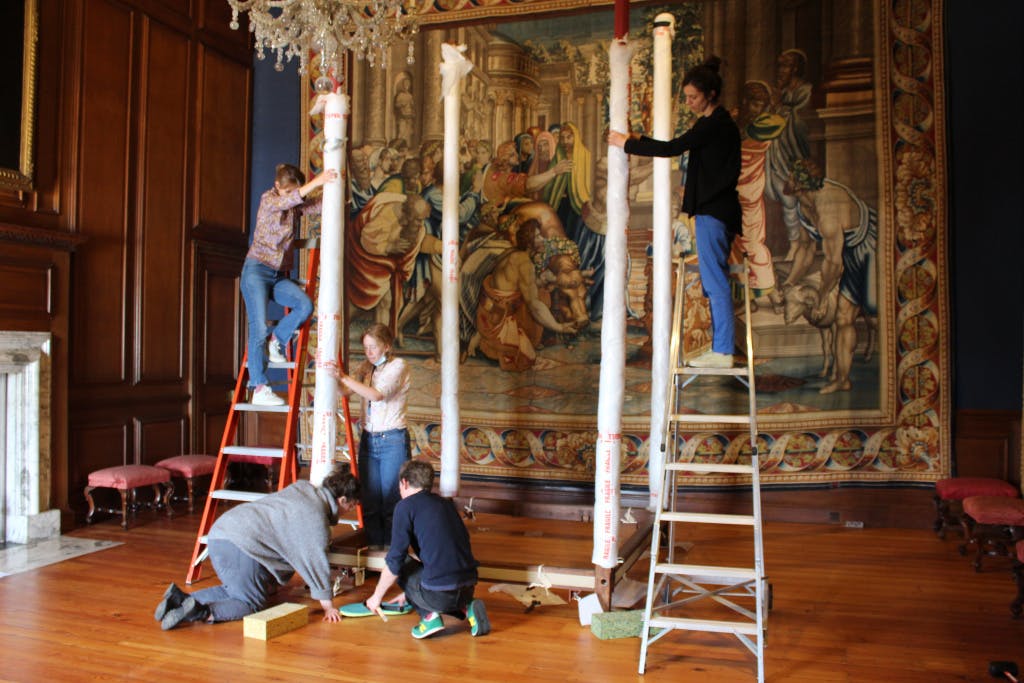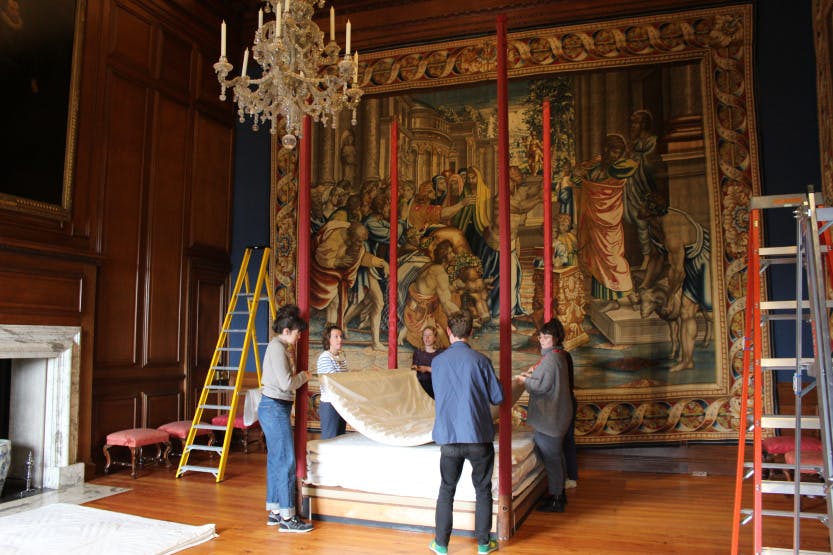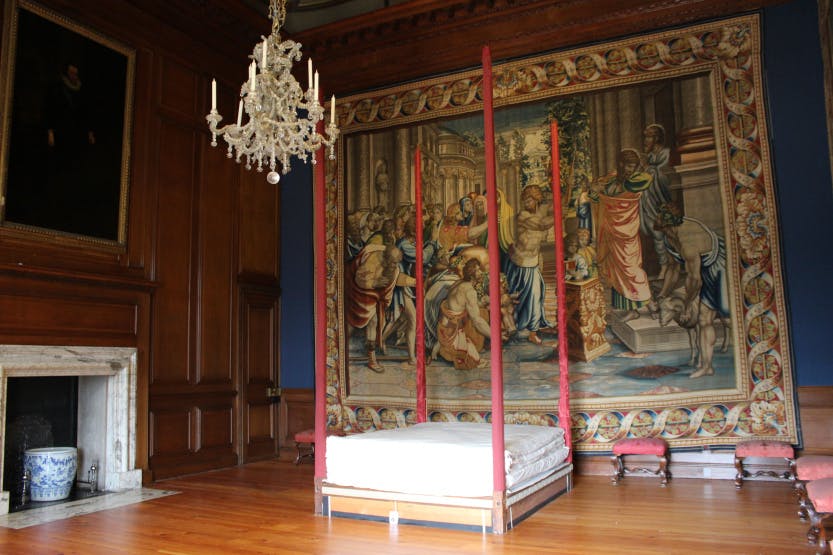Queen Caroline’s State bed is Back!... on Display
Secrets of a State Bed
Date: 09 April 2024
Author:
Rosie Chamberlin
When the pandemic struck, Historic Royal Palaces, like many heritage institutions, had to temporarily pause projects, including the conservation of Queen Caroline's State bed. We instead turned our attention to exhibition work to aid our financial recovery.
We can now return our focus to the permanent collection on open display across our palaces, including the much-loved Queen Caroline State bed that we care for on behalf of the Royal Collection Trust.

Image: The Queen's State Bedchamber in the Georgian Apartments at Hampton Court Palace. © Historic Royal Palaces
Reading over past blog posts in the Secrets of a State Bed series (the last one dated 2020), I noticed a comment from a restorer asking whether we would ever 'show or publish the naked frame, timber joints or any restoration work?' Well, dear reader you are in luck!
With 51 parts of the bed having received conservation treatment and only 21 outstanding, we have now begun part-reassembling the bed.
Since returning to this project, the newly-merged furnishings and tapestry team of five textile conservators (including one intern) have worked alongside an outsourced furniture conservator to return 35 parts of Queen Caroline’s State bed to their intended setting; the Queen’s Bed Chamber at Hampton Court Palace.
In spring 2022 we undertook the first phase of installation, which included reinstating four bed posts, four sections of bed frame, two rails, seven slats and three kickboards, all held together with steel brackets and original tongue and groove joints. The assembled bedstock was then topped with six mattresses, which were themselves conserved.
With the help of the Hampton Court Palace Salvage team, made up from staff across the site, we were also able to temporarily install the tester or canopy of the bed at the end of the Queen’s Gallery.
Although still to receive conservation treatment, having the tester on display allows everyone a rare opportunity to view up-close what is normally situated 16 feet above the floor, on top of the bedposts. We can experience what Queen Caroline would have been looking up at if she was lying in bed in 1715.

Image: The tester on display in the Queen’s Gallery. © Historic Royal Palaces / Royal Collection Trust / © His Majesty King Charles III 2024
The second phase of installation took place in Autumn 2023, when we installed a further nine lower parts of the bed. This included the conserved bolster (a cylindrical pillow that sits at the head of the bed), three base valances (textile hangings that surround the bottom of the bed), three base mouldings and two bed feet (intricately carved decorative elements covered in silk damask). You can see this second phase on the Historic Royal Palaces Instagram page.
It is standard practice at Historic Royal Palaces to reinstall a bed all in one go once conservation is completed. However, given the time that has passed and the fact that we are now working with a reduced team, working incrementally has allowed for a more considered approach.
It has enabled us to properly understand how complex pieces fit together and the best way to conserve and display the bed going forward. It has also provided learning opportunities for three interns and given visitors unprecedented access to parts of the bed normally hidden from view, a privilege usually only enjoyed by the conservators that work on such objects.

Image: Queen Caroline’s State bed as it can currently be seen in the Queen’s Bed Chamber at Hampton Court Palace. © Historic Royal Palaces / Royal Collection Trust / © His Majesty King Charles III 2024

Image: Team members from the first phase of installation; Rosie Chamberlin, Viola Nicastro, Louise Davison, Tristram Bainbridge, Kate Orfeur and Camilla Jokobson. © Historic Royal Palaces / Royal Collection Trust / © His Majesty King Charles III 2024
Visitors to Hampton Court Palace can now see the four original bedposts, normally hidden by the bed’s curtains, which are thought to be made from the centre (or heart wood) of mature, potentially Tudor, oak trees.
The eagle-eyed visitor will also notice that the two bedposts at the foot end of the bed, have been placed in custom-made case covers to protect the original silk damask from light damage and abrasion whilst on open display.
It can also be observed that the bolster similarly, once conserved, has been placed in a custom-made case cover, this time to protect against insect pests. The bolster, like the mattresses, is made up of lots of tasty proteinaceous fibres that insect pests like to nibble on. By placing these vulnerable materials in closely woven cotton bags sealed with Velcro we can protect them against insect pest damage and preserve them for future generations.
This work would not have been possible without the hard work and dedication of Kate Orfeur, Alice Young, Anne-Marie Britton, Viola Nicastro, Camilla Jokobson, Kirstin Ingram, Tristram Bainbridge and Louise Davison. Thanks are also owed to the Salvage and the Preventive Conservation teams at Hampton Court Palace.
Historic Royal Palaces is an independent charity, proud to be the guardian of six wonderful palaces. If you love the palaces and believe in what we do, find out how you can support us here.
More from our blog

Queen Caroline's bed undergoes conservation: Secrets of a state bed
15 August 2019
As supervisor of the furnishing conservation team at Historic Royal Palaces, I lead a team of four conservators over five years to conserve one of our tallest beds, Queen Caroline's state bed. The bed is part of the Royal Collection, and can usually be found on display at Hampton Court Palace.

Glorious Georgian Bathing: Queen Caroline's bath tub
23 September 2014
Hot water, soap, and shampoo; for most of us this is the start of our day. A shower or bath each morning is a habitual part of modern life that the majority of us couldn't go without.

Conserving a Victorian Child's Dress Worn for a Wedding
18 May 2018
A new addition to our Royal Ceremonial Dress Collection, this velvet and silk child’s dress was worn to celebrate the wedding of the future Edward VII; Prince Albert Edward, the eldest son of Queen Victoria and Princess Alexandra of Denmark on 10 March 1863.



